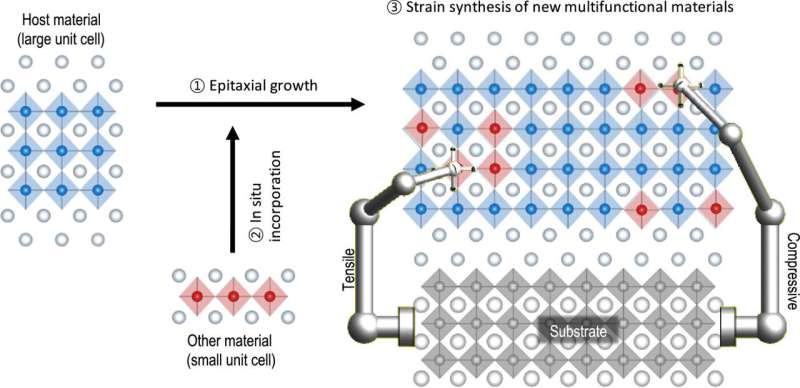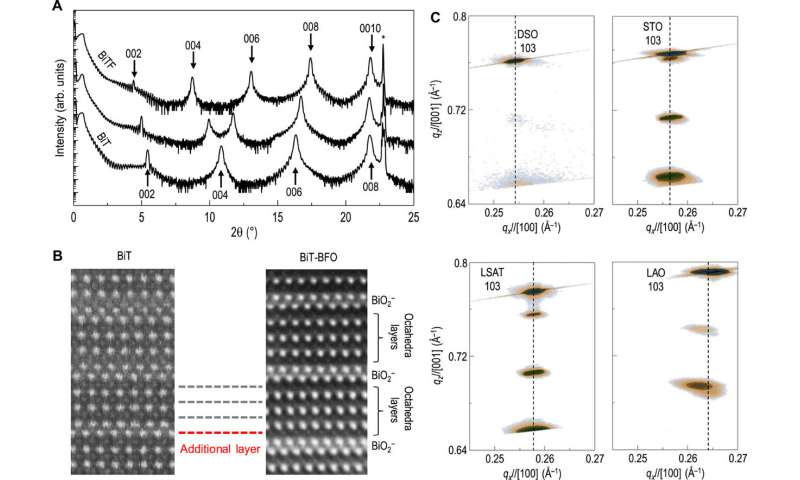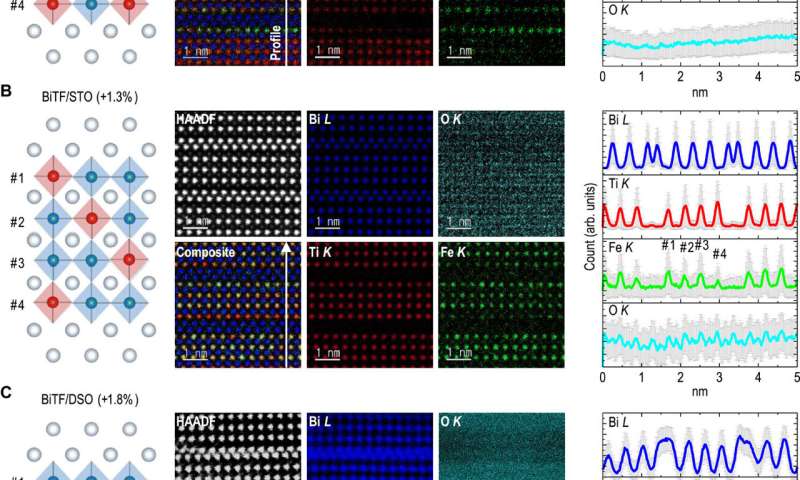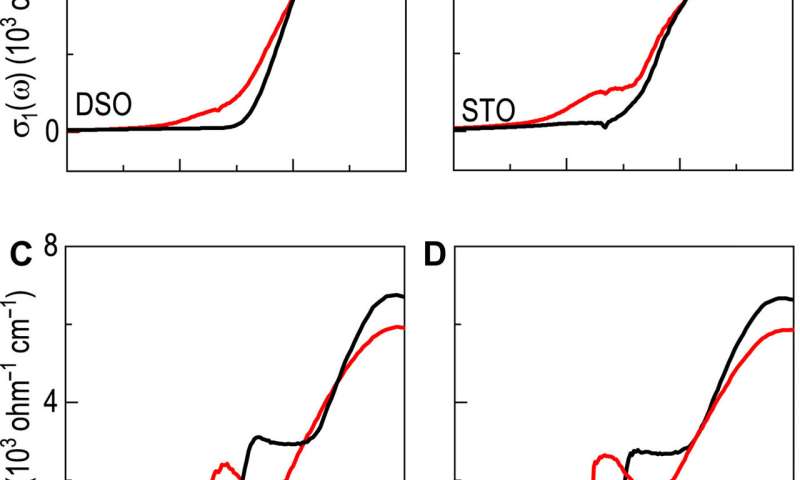June 3, 2021 feature
Strain-driven autonomous control of cation distribution for artificial ferroelectrics

Thamarasee Jeewandara
contributing writer

Theoretical material design and experimental synthesis have advanced in the past few decades with a key role in the development of functional materials, useful for next generation technologies. Ultimately, however, the goal of synthesis science remains to be achieved in order to locate atoms in a specific position of matter. In a new report now published on Science Advances, Changhee Sohn and researchers in materials science and nanostructure physics in the U.S. and the Republic of Korea developed a unique method to inject elements in a specific crystallographic position in a composite material via strain engineering. The team showed a powerful way to use strain to artificially manipulate the atomic position for the synthesis of new materials and structures. The results are applicable to a wide range of systems to provide a new route to functional materials.
Using strain to develop new materials.
Epitaxial strain originates from the lattice mismatch between a film and a substrate to manipulate important physical properties of materials. They have also to develop fast central computing processors. Ferroelectricity and its potential for ultrahigh density memory shows the importance of strain engineering in future technologies. In a recent , researchers proposed an unreported role of strain to develop new materials by inserting and repositioning individual atoms in a site-specific manner within a unit cell of materials. Using this strain-driven method, Sohn et al. combined layered perovskite materials such as Bi4Ti3O12 (abbreviated as BiT) and with the general formula ABO3. The BiT is a unique ferroelectric material with three oxygen octahedral sublayers sandwiched between two BiO2- layers. In a separate synthetic approach, Sohn et al. formed a composite Bi5Ti3FeO12 (BiTF) at the subunit level by strain and controlled the inserted iron (Fe) ions at the subunit level. During the experiments, they used pulsed laser deposition with two targets Bi4Ti3O12 (abbreviated as BiT) and bismuth ferrite (BiFeO3), abbreviated BFO, to demonstrate the growth control of composite materials by alloying BFO with layered BiT. During the experiments, they ablated the material at subunit cell level on (SrTiO3) substrates to precisely control their composition. Using (STEM), the team visualized the complete insertion of the additional octahedral layers between adjunct BiO2- layers. They obtained (HAADF) images of BiT and BiTF films grown on strontium titanate substrates, where the bright and intense signals arrived from heavy bismuth (Bi) ions and weaker signals arrived from the lighter titanium and iron ions. Using the two-target method, Sohn et al. also synthesized epitaxial BiTF thin films on various substrates with different directions and magnitudes of strain.
-

Structural characterization of BiTF thin films grown on various substrates. (A) X-ray diffraction θ-2θ scans of BiTF composite films with the different fraction of BFO blocks. The θ-2θ scans show the structural evolution from BiT with three octahedral layers to BiTF with four octahedral layers as BFO blocks are inserted. The asterisk indicates the 001 peak from the STO substrate. arb. units, arbitrary units. (B) HAADF images of BiT (left) and BiTF (right) composite films. While gray dashed lines are three octahedral layers already existing in the BiT film, the red dashed line shows an additional octahedral layer in the BiTF film. It indicates complete insertion of a BFO perovskite block into BiT structures. (C) Reciprocal space maps of strained BiTF films grown on four different substrates. Black dashed lines highlight the substrate (103) qx. Credit: Science Advances, doi: 10.1126/sciadv.abd7394 -

Strain-dependent Fe distribution in BiTF films. Atomically resolved STEM-EDX mapping of BiTF grown on (A) LAO (−0.9%), (B) STO (1.3%), and (C) DSO (1.8%) substrates. The leftmost column exhibits schematic diagrams of local Fe distribution in BiTF. The middle column exhibits HAADF, element-selective EDX, and overlaid EDX images. The Fe K-edge mapping shows that Fe ions are preferentially located at outer (inner) octahedral layer in BiTF/LAO (DSO) and randomly distributed in BiTF/STO. The rightmost column is line profiles of each element along the white arrows in EDX maps. Credit: Science Advances, doi: 10.1126/sciadv.abd7394 -

Bandgap reduction and unexpected out-of-plane ferroelectric polarization in BiTF films. (A to D) σ1(ω) of BiT (black) and BiTF (red) films on each substrate. The observed reduction of the bandgap by inserting BFO blocks implies that charge transfer energy between Fe 3d and O 2p orbitals is smaller than that between Ti 3d and O 2p orbitals. Credit: Science Advances, doi: 10.1126/sciadv.abd7394
Experimental observations
To understand the strain-dependent distribution of Fe ions in the materials at the atomic scale, Sohn et al. conducted combined with STEM (scanning transmission electron microscopy) on BiTF films. Using atomically resolved energy dispersive X-ray (EDX) mapping, the team revealed the distinct evolution of the material. The excellent agreement of the role of strain with the theoretical prediction supported its role in controlling the Fe ion distribution in the film. The scientists were also keen to understand how inserting and positioning Fe ions into BiT affected the macroscopic properties of the film. To accomplish this, they fist focused on the optical properties important to understand electronic structures at the fundamental level and for technical applications. After inserting BFO blocks the scientists observed bandgap reduction. Sohn et al. also observed the relationship between ferroelectricity of BiTF films and the cationic distribution of iron ions. Thereafter, using (cKPFM), they examined the piezoelectric properties of the films to note strong substrate dependence on lateral and vertical ferroelectricity.
![Strain-dependent in-plane and out-of-plane ferroelectric polarizations in BiTF films. (A to D) Lateral cKPFM measured along the orthorhombic [100] direction after application of different voltage pulses, as a function of read voltage. Clear hysteresis behaviors are observed in the films on LSAT and STO substrates, while ferroelectricity is unclear and strongly suppressed in the films on LAO and DSO. This result implies that the randomness of Fe ion position plays a role in stabilizing the ferroelectricity. (E to H) Vertical cKPFM curves of BiTF films on each substrate. Only the film on STO shows clear out-of-plane ferroelectric hysteresis behaviors, which are forbidden by symmetry in bulk. We attribute this unexpected polarization to extrinsic asymmetry of cationic distribution signified with intrinsic random preference by moderate tensile strain. Credit: Science Advances, doi: 10.1126/sciadv.abd7394 Strain-driven autonomous control of cation distribution for artificial ferroelectrics](https://scx1.b-cdn.net/csz/news/800a/2021/strain-driven-autonomo-4.jpg)
Outlook
In this way, Changhee Sohn and colleagues demonstrated the unique strain-driven synthetic paradigm that allowed researchers to insert atoms and autonomously direct them to a specific crystallographic position of matter. The method is distinct from well-known methods of synthesis such as conventional heterostructure engineering or simple alloying of two different materials. The strain-driven artificial control of atomic positions can boost research in materials science and condensed matter physics to develop multifunctional composite systems. Based on this method, Sohn et al. expect to synthesize multiferroic materials and control their magnetic ground state through cationic distribution.
Written for you by our author —this article is the result of careful human work. We rely on readers like you to keep independent science journalism alive. If this reporting matters to you, please consider a (especially monthly). You'll get an ad-free account as a thank-you.
More information: Sohn C. et al. Strain-driven autonomous control of cation distribution for artificial ferroelectrics, Science Advances, 10.1126/sciadv.abd7394
Lee H. et al. Strong polarization enhancement in asymmetric three-component ferroelectric superlattices, Nature, doi:
Chakhalian J. et al. Orbital reconstruction and covalent bonding at an oxide interface, Science, 10.1126/science.1149338
Journal information: Science Advances , Nature , Science
© 2021 Science X Network




















